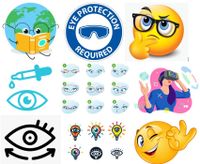Expansion of the Disaster Preparedness Portfolio - "Eyes" Theme
We've thoroughly discussed the topic of "vision problems" within our disaster management framework, but what could we do to create a slightly better starting position?
To minimize eye problems and maximize efficiency and safety, we can take the following (possible) additional measures:
1. During disaster operations, protective goggles should always be worn to protect the eyes of those affected from dust, debris, and other harmful particles. Mobile easy-to-set-up stations could be installed in the operation area to provide quick eye rinses with sterile solutions.
2. Training emergency responders in handling eye problems and educating them about preventive measures can improve safety and efficiency. A medical expert could give a lecture on the most common eye problems that can occur during an operation, such as conjunctivitis, dry eyes, and eye fatigue. The responders learn to recognize the symptoms of these eye problems and understand how they can affect vision. They learn, for example, the proper application of eye drops or how to keep the eyes optimally hydrated during long operations.
3. An ergonomics expert provides valuable tips on reducing eye strain, especially during extended use of maps and screens.
4. Practice realistic simulations and operational scenarios to efficiently conduct tasks despite eye problems. Use VR goggles to create various simulations of eye problems. Another option would be conducting interactive workshops where participants experience eye problems firsthand through role-playing. Regular checkpoints to check eye health during training.
5. Introduce apps that help detect eye problems early, as well as apps that offer specific exercises and routines to strengthen eye muscles and remind people to take regular breaks.
6. Guided exercises to strengthen eye muscles and massage techniques to relax the eyes. Mindful, increased blinking when experiencing acute eye fatigue. Consistent exercises alternating between near and far vision. Learning eye massages to relieve tired eyes. Train the auto-focus of the eyes, for example, by holding your hands close to your face and focusing on your palms. After a few seconds, separate your hands and focus on the background a few meters behind them. Another method is palming, where you rub your hands together until they feel warm and perhaps tingly, then place your warm palms over your closed eyes for 30 seconds. Regular breaks to relax the eyes. Even emergency responders should be instructed to take a short break every 20 minutes and look into the distance to relax eye muscles. There are many possibilities for relaxation and relief exercises.
7. Introduce integrated training that combines breathing techniques and eye exercises to relax the eyes and improve blood circulation.
8. Live demos on the proper application of eye drops, as well as mobile stations and emergency kits with eye drops and hydration kits for quick relief from dry or irritated eyes. Another option would be contact lenses with built-in sensors that monitor the moisture level of the eyes and release a soothing film as needed, or portable devices that generate a fine mist of saline solution to provide moisture or relieve irritation. Keep cold compresses on hand! Placing a clean, cold cloth over the eyes can help reduce swelling and irritation. A sterile saline solution can be used to rinse the eyes and remove irritants. Chamomile has soothing and anti-inflammatory properties. A lukewarm chamomile tea bag can be placed on the closed eye to relieve irritation. Think about easy-to-use disposable eye patches containing natural ingredients like chamomile or reusable microfiber eye masks that are gently placed over the eyes and filled with soothing herbs.
9. Providing spare glasses in emergencies, but also blue light filter glasses and glasses specifically designed for outdoor use with high UV protection to shield eyes from harmful sunlight. It's also important to customize protective goggles. Another option would be special glasses that use phototherapy technology to soothe and relax the eyes (they are equipped with LEDs that emit controlled light in therapeutic wavelengths). Multifunctional protective goggles could also be considered, which in addition to physical protection, have integrated air filter systems to keep dust and allergens away.
10. Lighting: Use portable, battery-powered LED lights that provide bright, even light without flickering. Integrate dimmers and color temperature controls to adjust the light intensity and color to the specific needs of the response teams. Warm light colors can be used in the evening to relax the eyes, while brighter, cooler light ensures better visibility during the day. Introduce lamps with anti-glare technology to minimize glare and reflections. This helps reduce eye strain, especially during prolonged operations. Set up specific lighting zones in temporary shelters and work areas. Each zone has optimized lighting for the task at hand, whether it's reading, providing medical care, or general activities. Install safety lights along pathways and in hazardous areas. These lights should come on automatically when it gets dark to avoid trips and accidents.
11. Small portable air purifiers that could be placed in personal work and operational areas to reduce dust and allergens.
...
Scenario: Natural Disaster Deployment and Eye Care
A team of disaster responders works in an earthquake zone where dust and debris can lead to severe eye irritation. The following could be prepared and used for eye "care":
- Cold Compresses: A mobile first aid kit could include clean, reusable cloths and a thermal container with cold water. Responders can use these cloths for quick eye compresses to relieve swelling and irritation.
- Saline Solution: A portable container with sterile saline solution could be included in the first aid kit. Responders can use the solution to rinse away dirt and foreign objects from their eyes, especially after working in dusty environments.
- Chamomile Tea/Fennel Tea: Small packets of chamomile or fennel tea could be made available at the base camp. Responders could brew them and, after cooling, briefly place the tea bags on their eyes to soothe irritation and calm the eyes.
- In a makeshift camp for disaster responders, there could be a canteen that also serves as a place for relaxation and recovery. The canteen could stock fresh potatoes, not only for meals but also for eye care; responders could place fresh potato slices on their closed eyes to relieve irritation during their breaks and refresh their eyes (about 10-15 minutes, which helps to calm the eyes and reduce swelling). This method can be offered as a complementary measure to other eye care techniques and aids, providing responders with a variety of options.
This contribution was written by Birgit Bortoluzzi, the creative founder of the “University of Hope” – an independent knowledge platform with a mission: to make resilience, education, and compassion visible and audible in a complex world.


